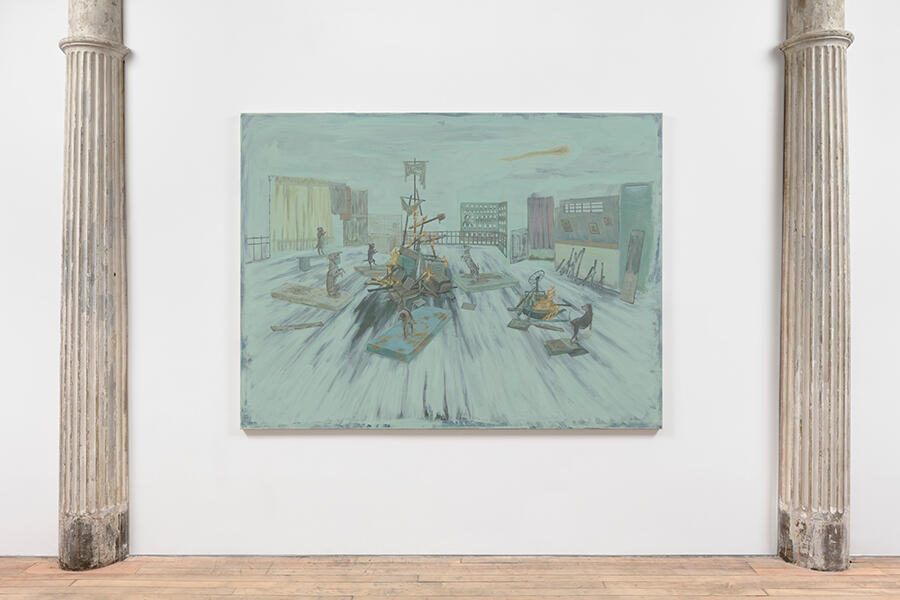Shows to See in the US and Mexico This January
From New Orleans much-anticipated Prospect.5 to Naudline Pierre's first institutional solo exhibition, these are the unmissable shows to see this month
From New Orleans much-anticipated Prospect.5 to Naudline Pierre's first institutional solo exhibition, these are the unmissable shows to see this month


The New Museum Triennial
28 October 2021 – 23 January 2022
Featuring 41 artists, the 2021 New Museum Triennial, ‘Soft Water, Hard Stone’, co-curated by Margot Norton and Jamillah James, takes as its overarching theme the perseverance that emerges from ‘precarity and changeability’, and that ‘breathe[s] new life into the remains of collapsed constructs’, as Norton notes in her essay ‘The Moment of Change Is the Only Poem’, which opens the exhibition catalogue. From Gabriela Mureb’s kinetic floor sculpture Machine #4: Stone (Ground) (2017), in which an electrically powered rod slowly and endlessly hits a small stone, to Jeneen Frei Njootli’s Fighting for the title to not be pending (2020) – shimmering beads, whose composite weight equals that of the artist, scattered in the cracks and corners of the museum’s floors – plenty of works this year, while unobtrusive, disperse actions and gentle force. — Ela Bittencourt

Naudline Pierre
Dallas Museum of Art
26 September 2021 – 15 May 2022
In the sixth chapter of the biblical Book of Isaiah, the narrator recounts a vision of the seraphim – angels whose form is mysterious and untamed compared to the more familiar, porcelain-skinned figures depicted in the 15th-century Florentine frescoes of Fra Angelico, for instance. On view at the Dallas Museum of Art, New York-based painter Naudline Pierre’s debut institutional solo exhibition, ‘What Could Be Has Not Yet Appeared’, recalls this vision of angels as fiery messengers and supernatural guardians. Pierre began making ethereal, jewel-toned paintings of winged figures in subtly allegorical scenes as early as 2017. The two earliest paintings in the exhibition – Hold Me This Way and Closer Still (both 2017) – demonstrate the development of Pierre’s signature techniques and subject matter. — Logan Lockner

Alexandre Estrela and João Gusmão
Travesía Cuatro
3 November 2021 – 23 January 2022
For Alexandre Estrela’s first exhibition at Travesía Cuatro’s Mexico City outpost, the Portuguese artist has extended the invitation to his friend and collaborator João Maria Gusmão. Estrela and Gusmão share an interest in moving-image practices that combine abstraction with illusion. Their two-person show, ‘Día Eléctrico’ (Electric Day), revolves, as the title suggests, around temporal and spatial concepts related to (electric) luminescence. Every window of the gallery’s three-storey building is shuttered to prevent any sunlight from creeping in. The rooms and corridors are illuminated only by the artificial light generated by the numerous projectors and magic lanterns directed onto works on paper and the walls of the gallery. — Anna Goetz

Arturo Kameya
Grimm
15 December 2021 – 15 January 2022
Kameya’s ghosts are invoked through oneiric installations and paintings drawn from grainy photographs. Afterparty, which depicts a makeshift ancestral shrine, refers to more conventional notions of apparitions: acts of care and worship that cross the boundaries of life and death. The surface is muted, with the patina of an aged penny; it appears weathered, as if having been exposed to the sun and rain for many years before arriving in the gallery. (An effect the artist achieves by mixing clay powder into his paint.) — Simon Wu

Prospect.5
Various Locations
23 October 2021 – 23 January 2022
Prospect.5, curated by Naima J. Keith and Diana Nawi, is titled ‘Yesterday we said tomorrow’, and comes with a sense of deferred payoff, not to say justice. (Demography-watchers will note that Prospect.5 is the first iteration curated by women.) After all, yesterday’s tomorrow is today. The political vector of this edition feels concerned not just the revival of New Orleans but with the city as a metaphor for the country as a whole. The most pressing issues of the moment – conservative backlash, racial justice and climate change – manifest here in boldface. The city has been a major port for centuries, slumping into the Mississippi Delta all the while, which of course means New Orleans was a hub during the slave trade. Today, the city’s class disparity and racial segregation seem like perfectly pronounced metaphors for the entire US, as the sunken Lower Ninth Ward has come to represent the plight of vulnerable, low-income neighbourhoods in an age of wild climate. — Travis Diehl
Main image: Ambera Wellmann, Strobe, 2021, oil and mixed mediums on canvas, 2.7 × 9.1 m, the New Museum Triennial. Courtesy: © the artist and Company Gallery, New York























